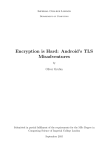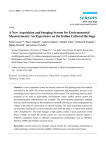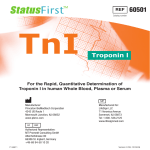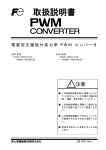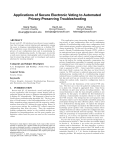Download Privilege Separation for Applications and Advertisers in Android
Transcript
AdDroid: Privilege Separation for Applications and
Advertisers in Android
Paul Pearce
Adrienne Porter Felt
Gabriel Nunez
David Wagner
Electrical Engineering and Computer Sciences
University of California at Berkeley
Technical Report No. UCB/EECS-2013-59
http://www.eecs.berkeley.edu/Pubs/TechRpts/2013/EECS-2013-59.html
May 14, 2013
Copyright © 2013, by the author(s).
All rights reserved.
Permission to make digital or hard copies of all or part of this work for
personal or classroom use is granted without fee provided that copies are
not made or distributed for profit or commercial advantage and that copies
bear this notice and the full citation on the first page. To copy otherwise, to
republish, to post on servers or to redistribute to lists, requires prior specific
permission.
AdDroid: Privilege Separation for Applications and
Advertisers in Android
Paul Pearce, Adrienne Porter Felt
Computer Science Division
University of California Berkeley
{pearce, apf}@cs.berkeley.edu
Gabriel Nunez
David Wagner
[email protected]
Computer Science Division
University of California Berkeley
Sandia National Laboratory∗
ABSTRACT
Advertising is a critical part of the Android ecosystem—
many applications use one or more advertising services as
a source of revenue. To use these services, developers
must bundle third-party, binary-only libraries into their
applications. In this model, applications and their advertising libraries share permissions. Advertising-supported
applications must request multiple privacy-sensitive permissions on behalf of their advertising libraries, and advertising libraries receive access to all of their host applications’ other permissions. We conducted a study of the
Android Market and found that 49% of Android applications contain at least one advertising library, and these
libraries overprivilege 46% of advertising-supported applications. Further, we find that 56% of the applications with
advertisements that request location (34% of all applications) do so only because of advertisements. Such pervasive
overprivileging is a threat to user privacy. We introduce
AdDroid, a privilege separated advertising framework for
the Android platform. AdDroid introduces a new advertising API and corresponding advertising permissions for
the Android platform. This enables AdDroid to separate
privileged advertising functionality from host applications,
allowing applications to show advertisements without requesting privacy-sensitive permissions.
1.
∗
tom ringtone application) must request multiple privacysensitive permissions unrelated to its functionality just so
it can display advertisements. Advertising libraries often
require permissions for network connectivity, location information, and phone state.1 Since developers include the
advertising library as part of the application, applications
can use the permissions needed for advertising libraries,
and vice versa. This is an instance of overprivileging: the
advertising libraries require applications to take on additional privileges that they otherwise might not need. Moreover, these additional permissions have serious implications
for user privacy.
The current advertising model results in the following
classes of threats:
• Advertisers may track users without their knowledge.
• Untrusted applications may have access to unnecessary private data, such as the user’s location.
• If an adversary exploits a buggy application, the benign-but-buggy application may inadvertently leak or
expose sensitive information to attack.
• Malicious or opportunistic advertising networks could
abuse the permissions of their host applications.
• Applications frequently requesting sensitive permissions, or permissions unrelated to the application’s
functionality, can train users to ignore permission
warnings [13].
INTRODUCTION
The Android Market [2] has given Android developers
an avenue to rapidly develop and distribute applications
directly to consumers. Mobile advertising services such as
AdMob [1] and Millennial Media [22] play a key role in this
ecosystem by allowing developers to generate revenue from
advertisements. These advertisers distribute libraries that
make it easy for applications to request advertisements and
display them in their user interfaces.
Before developers can distribute an Android application,
they must identify and declare what permissions their applications need. The installation process shows these permissions to users if they choose to install the application.
However, the Android security model does not provide any
special support for advertisements. This means that there
is no way for the user or the operating system to differentiate between the permissions necessary for the host application and those needed by advertising libraries. A simple
advertisement-supported application (e.g., a game or cusWork done while at the Computer Science Division, University of California Berkeley.
[email protected]
• Advertising libraries have been observed downloading code over HTTP and dynamically executing it at
runtime [14].
To combat these threats we propose AdDroid, an extension of the Android platform that provides special support
for advertisements. In AdDroid, the host application and
the core advertising code run in separate protection domains. We accomplish this privilege separation by moving privileged functionality into a new Android system
service. Application developers may incorporate advertisements into their application by invoking the AdDroid
advertising application programming interface (API). Applications using AdDroid no longer need privacy-sensitive
permissions just to display advertisements.
1
Applications need phone state to obtain the phone’s International Mobile Equipment Identity (IMEI). Developers
can use the IMEI as a unique customer identifier.
To understand the potential value of AdDroid, we analyzed a set of 964 real-world Android applications collected from the Android Market. We found that 49% of
applications contain at least one advertising network library. We also found that application developers overprivileged 46% of advertising-supported applications (23%
of all applications) by one or more permissions as a direct result of their use of advertising libraries. Further,
we found that 27% of advertising-supported applications
receive both Internet connectivity and location information, even though the application needs neither for its
functionality. This particular combination of permission
overprivilege is potentially sensitive because it allows applications to track a user’s location without their knowledge. Lastly, we found that 34% of all applications (56%
of advertising-supported applications) that request location do so only because of advertisements. With AdDroid,
27% of advertising-supported applications would no longer
need Internet access, 25% would no longer need location
information, and 8% would no longer need phone state information. Overall, AdDroid would reduce overprivileging
in 46% of advertising-supported applications.
Figure 1: At left, an application’s requested permissions are shown as part of the installation process. At right, an example of an advertisement (top
of screen) in an application.
Contributions. The contributions of this work include:
• We identify and detail the problem of advertisingrelated overprivileging, including a detailed model of
the threats faced by users and developers (Section 2).
• We design and implement AdDroid, a solution to the
threat of advertising overprivilege that applies privilege separation to advertising libraries (Sections 3
and 4).
• We measure the threat of advertising overprivilege
and the impact of AdDroid with an advertising and
overprivilege measurement study performed on applications from the Android Market (Section 5).
2.
BACKGROUND
To frame the problem, we describe the Android permission system and explain how mobile advertising currently
works. We then explain how the current system leads to
privacy and security threats from legitimate advertising
networks, grayware, benign-but-buggy applications, malicious advertising networks, and vulnerable advertising networks.
2.1
Android Permissions
Android employs an install-time permission system to
alert users to the privacy and security ramifications of installing an application. A permission gives an application the ability to perform a specific privacy- or securityrelevant action. For example, the INTERNET permission
controls communication with remote servers, the RECORD_AUDIO permission provides the ability to record audio with
the microphone, and the ACCESS_FINE_LOCATION permission permits access to the phone’s GPS location. An application cannot perform a given operation unless it has
the related permission.
In order to gain permissions, applications must first request them. Developers determine (e.g., via testing) the
permissions that their applications require, and then they
bundle their applications with the appropriate list of permission requests. Different applications request different
sets of permissions, based on their functionality.
The Android installer asks users to grant these permission when they install the application. After initiating the
installation process, the system shows the user the list of
permissions that the application requests. Figure 1 shows
a screenshot of the permission authorization process in the
Android Market. The user implicitly accepts the permission requests by choosing to complete the installation process. Permission authorization is all-or-nothing; the user
must accept all of the application’s permission requests or
cancel installation. Once installed, these permissions will
be available to the application each time it executes.
2.2
Advertising Libraries
Advertising networks serve as middlemen between application developers and advertisers. The advertising networks supply developers with advertising libraries, and developers place the libraries in their applications. The libraries provide APIs for inserting advertisements into the
application’s user interface and handle the fetching, rendering, and tracking of advertisements. These libraries are
responsible for 65%-75% of energy usage in free applications [23].
In Android all parts of an application—including the advertising libraries—have the same permissions. This has
two consequences. First, an advertising library can use
all of the permissions that its host application requests.
Second, an application that includes an advertising library
must request all of the permissions that the advertising library requires. Figure 2 shows the relationship between
advertising libraries, applications, and the Android permission system. Android system services perform privileged operations. Applications access these services via
inter-process communication (IPC), and the system services will only perform operations that applications have
permissions for. While Android system services are able to
perform operations unconstrained by Android application,
unbranded games. Currently, there is no way for a
user to identify what data they give to the untrusted
application versus what data they give to the advertising network. Consider the case of the unbranded
game requesting location permissions. There is no
way to determine if the game is taking that location
information and using it in some way contrary to the
user’s privacy, or if a reputable advertising network
is using the location to serve location relevant advertisements.
Application Process
Host Applicaton
Android System
Services
API Calls
Android SDK
Ad Lib
A
Ad Lib
B
Android Permission Checks
Inter-Process Communication
Android Kernel
Figure 2: Diagram showing how advertising currently works in Android. The example application
uses two advertising networks. Each advertising
library access the privileged Android system services via IPC. The Android system does not distinguish between different parts of an application.
• Benign-but-buggy applications. The more permissions
a user grants to an application, the more damage it
can do if exploited [25]. If an overprivileged application contains bugs, an attacker could make use of
these additional privileges to track users, exfiltrate
data, and violate user privacy. A buggy application
could also unknowingly leak private information it
had access too.
they do not run as “root.”2
Certain permissions are commonly associated with advertising libraries. Advertising libraries load advertisements from remote servers, which requires the INTERNET
permission; they may also use the ACCESS_NETWORK_STATE
permission to determine whether the phone has access to
the Internet. To support location-specific advertisements,
applications must request one of the LOCATION permissions
(either GPS or network location). Some advertising networks use the READ_PHONE_STATE permission to obtain the
phone’s IMEI, which can serve as a unique customer identifier. Advertising networks publish documentation that
instructs developers to include these permissions in their
lists of required permissions.
2.3
• Malicious advertising networks. An unscrupulous advertising network could supply application developers with a malicious library that abuses the permissions requested by host applications. Although we
are unaware of existing malicious mobile advertising
networks, malware has appeared in the Android Market [11], and malicious advertising partners have collaborated with botnets in other settings [21]. A less
severe variant of this threat is an opportunistic advertising library that uses aggressive, borderline-legal
marketing techniques. An example of an opportunistic threat would be a library that collects users’ phone
contact lists to send spam. Opportunistic advertising libraries that check for and use their host applications’ permissions have been seen in the wild [14,
27].
Threat Model
Besides potentially training users to ignore sensitive permission requests [13], five threats arise from the Android
advertising ecosystem:
• Legitimate advertising networks. Studies suggest that
a majority of users have experienced discomfort sharing personal information such as location and browsing history with advertising networks [20, 17, 5]. The
purpose of the Android permission system is to inform users about what personal information they will
share with a third party, but Android users are currently unable to tell which permissions advertising libraries use. Consequently, users are unaware of what
information applications or advertising libraries are
sharing with advertising networks and are unable to
object to advertising libraries’ permission requests.
While users can usually identify whether an application contains advertisements, this may only become
apparent after they install and use the application.
More importantly, users can not tell what information (e.g., location) the application is sending to advertisers.
• Grayware. In some situations, users may trust advertising networks more than the application. For example, consumers might be willing to share their location with Google’s advertising network but not with
2
One can think of the Android system services as running
with the permissions of a traditional Linux process.
• Vulnerable advertising networks. Advertising libraries have been observed downloading code over HTTP
and executing it [14, 27]. This behavior could turn a
legitimate advertising network into a malicious one if
the user is connected to an unsafe wireless network.
In each of these threats, providing applications and advertising libraries with unfettered access to each other’s
permissions poses significant danger.
3.
PROPOSAL
We propose to use privilege separation [24] to address
the threats outlined in Section 2. In general, privilege separation involves placing the privileged components of the
application in a different protection domain from the rest
of the application, and assigning a different set of permissions to each domain. In this context, we suggest placing
the privileged parts of the advertising library in a separate protection domain, and assigning it a separate set of
permissions.
We begin by exploring two traditional solutions for privilege separation: separation within a process and separation
between processes. Then, we explain why these solutions
are inadequate in the context of Android advertising. We
then present an alternative solution, our system AdDroid.
3.1
Privilege Separation Within A Process
A natural approach is to introduce a finer-grained permission model, where an application can consist of multiple
protection domains, each with its own code and associated
set of permissions. It is tempting to assign each Java class
to its own protection domain, with all protection domains
running in the same virtual machine and process. This
would let the advertising library exist in the same process
and Java runtime as the rest of the application, but with
different permissions. Under this proposal, method calls
between the library and application remain unchanged because they are in the same virtual machine, yet the advertising library and application have their own permissions.
Unfortunately, there are two technical problems with
this solution. First, some applications include native libraries, which can arbitrarily violate the integrity of the
virtual machine running in the same process [10]. Second,
the Dalvik virtual machine (which executes Android Java
code) does not support isolation between portions of code
within the same virtual machine, which would be necessary to prevent one part of an application from interfering
with or altering other parts of the application. Java includes a reflection library that explicitly allows other code
to violate code encapsulation and integrity running in the
same virtual machine. Consequently, we do not think it
is feasible to separate the privileges of an application and
its advertising library within a Dalvik virtual machine or
process.
3.2
Privilege Separation Between Processes
Another approach is for advertising libraries to exist as
separate, standalone applications. These advertising applications would run in separate processes from the user application. When a user installs an application with advertisements, the user-selected application would install the
appropriate advertising application. User-selected applications would either interact with advertising applications
via existing IPC mechanisms, or the Android system would
have to be modified to allow the user-selected and advertising applications to share the screen [7]. Advertising applications would consist of the current advertising library and
shim code to proxy information to and from the target application. The user-selected and advertising applications
would each run with their own sets of permissions. As
we envision it, user-selected applications would request a
new ADVERTISING permission in order to display advertisements, and the system would allow advertising applications
to use permissions associated with advertising such as INTERNET or LOCATION.
Unfortunately, there are numerous hurdles to implementing this approach on the Android platform, including:
• Users who do not want to look at advertisements
might uninstall the advertising applications. This
would hurt developers and companies that rely on
advertising revenue. Application developers expect
users to “pay” for free (i.e., subsidized) applications
by viewing advertisements.
• The ADVERTISING permission is necessary to warn
users that the selected application transmits data to
an advertising network through an advertising application. However, it would be difficult to enforce
this permission. Once a user or host application
has installed an advertising application on a phone,
other user-selected applications could communicate
with it to load advertisements. Advertising applications could refuse to service user-selected applications
that lack the ADVERTISING permission, but this relies
on the advertising applications to enforce the permission requirement. Since advertisers have an incentive
to show advertisements to as many applications as
possible, they are incentivized to not enforce these
permissions. The Android Market could refuse to
list advertising applications unless they abide by this
constraint, but this would require periodic audits of
advertising applications.
• The Android platform would need to be extended
to support install-time dependencies between applications so that advertisement-supported applications
could list an appropriate advertising application from
their preferred advertising network as a prerequisite.
The platform would also need to support runtime application dependencies. This would require changes
to the Android platform, the Market, and the user
interface for application installation. Such changes
could present unforeseen abuse opportunities. There
is also a potential for reliability and security concerns if the market must manage separate advertising applications for all possible advertising networks.
Each phone would need to maintain copies of the
versions needed by all of the installed applications.
This presents significant logistical obstacles for deployment.
• The Android Market would need to prevent the distribution of impostor advertising networks. An impostor advertising network would collect all of the
information sent to it without paying the developer
and without the privacy policy of a reputable advertising network.
Consequently, we believe the solution of standalone advertising applications will not suffice. Therefore we present
a modified and extended IPC approach which leverages
existing infrastructure in the Android platform.
3.3
Our Proposal: AdDroid
We propose AdDroid, a solution which integrates advertising into the Android platform. In this solution, advertising networks do not provide advertising libraries at all.
Instead, the Android API is extended to support advertising. The extended Android API relays advertising metadata from applications to advertising networks, fetches advertisements from advertising networks’ servers, and handles user interface events. Applications provide the API
with configuration data to identify which advertising network(s) to fetch advertisements from, as well as contextual
information about the advertisement. This modification to
the Android platform introduces a model similar existing
system services, and relies on mechanisms already in the
platform.
We also propose the addition of two new permissions:
ADVERTISING and LOCATION_ADVERTISING. Applications
wishing to take advantage of AdDroid would request one
of these permissions, which would give them access to the
new advertising API calls. Advertising-supported applications would not need to request additional permissions for
Application Process
Android System
Services
Host Applicaton
API Calls
Android SDK
AdDroid
Library
Service
A
Service
B
AdDroid
Service
Android Permission Checks
Inter-Process Communication
Advertising
Network
https
http
Phone
Web
s
Android Kernel
Advertising
Network
Figure 3: The AdDroid design. Key components
include a userspace AdDroid library that adds advertising support to the public API, and a supporting AdDroid system service that communicates
with the advertising network’s Internet servers.
advertising (e.g., LOCATION) because all of the privileged
advertising-related operations would be performed by AdDroid on behalf of the application. Applications requesting
these permissions will not have unfettered access to Internet, location, or phone identifying information. These
permissions will only grant them access to parts of the
advertising API.
Figure 3 shows a system overview of AdDroid. The Android SDK now includes additional advertising-related API
calls which are supported by a new system service. All of
the advertising-related code that does not require special
permissions resides in the Android SDK and does not need
to be trusted by the privileged Android components. Advertising functionality that requires permissions (e.g., connecting to the Internet) is implemented in the new service,
which can perform privileged operations. The advertising
system service is only accessible to applications with the
appropriate ADVERTISING or LOCATION_ADVERTISING permissions. In our proposal, all of the advertising-related
code that requires privilege is trusted enough to be part of
a system service because it has been written or reviewed by
the Android development team. Consequently, it is safe for
privileged advertising code to execute as a system service.
This solution mitigates our five threats as follows:
• Legitimate advertising networks. The advertising permissions inform users when applications make use
of advertising. In particular, the LOCATION_ADVERTISING permission informs users when applications
include location-aware advertisements. Armed with
this information, users can make informed decisions
about which applications to install, given their personal privacy preferences.
• Grayware. In AdDroid, applications can include advertisements without needing the LOCATION or READ_PHONE_STATE permissions. This enables users to distinguish between applications that use permissions
for their own purposes and applications that use permissions for advertising. For example, a person considering an unbranded game would know that the
game developer is collecting his or her information
for a purpose other than displaying location-aware
advertisements. We expect that our proposal would
significantly reduce the number of applications that
ask for Internet, location, and identity permissions,
which would make the permissions more notable and
therefore more effective. If these applications only
requested the advertising related permissions, they
would have no access to Internet, location, or phone
identification information.
• Benign-but-buggy applications. Since applications no
longer need to request permissions for their advertising libraries, many will have fewer permissions. This
means that a buggy application will be less likely to
have Internet, location, or phone state permissions,
thus reducing the impact of any vulnerability or bug
in the application.
• Malicious advertising networks. In our model, advertising networks do not provide any code directly
to developers choosing to use AdDroid. As such,
malicious advertising networks would not be able to
leverage application permissions to collect excessive
amounts of user data or perform undesirable operations.
• Vulnerable advertising networks. Since applications
would no longer embed advertising libraries in their
applications, advertising libraries cannot introduce
vulnerabilities into applications.
As such, we believe AdDroid addresses the privacy and security concerns about advertising identified in Section 2.3.
In addition to improving privacy, AdDroid provides other
benefits. Uniting advertising networks under a common
API would decrease developer overhead, particularly for
applications that use multiple advertising networks. In
turn, this gives advertisers more potential customers, as
every developer would be able to opt-in to advertisements
using a familiar, standardized API. The creation of an ADVERTISING permission also allows the Android Market to
become advertising-aware. The Market could allow users
to sort applications based on whether they include advertisements. Additionally, the Market could support a feature that allows users to switch to the paid version of an
application (e.g., if the user does not like the advertisements in the free version).
Section 4 discusses the AdDroid implementation in more
depth. Section 5.6 discusses AdDroid’s ability to support
multiple advertising networks further.
3.3.1
Existing Applications and Libraries
AdDroid does not prevent the continued use of the existing bundled library model. Applications and advertising
networks that do not use AdDroid simply do not receive
the benefits of the system. Existing applications and advertising networks will continue to function normally. In
the long term, we would expect the benefits of AdDroid
and changing user expectations to entice developers to migrate their applications and advertising libraries.
3.3.2
Limitations
The AdDroid proposal has two drawbacks. First, the
Android development team would need to implement Ad-
Droid and incorporate the functionality of existing advertising libraries into the Android API. However, we show in
Section 5.6 that advertising functionality is relatively simple to support. Second, existing advertising networks are
currently able to declare and update their APIs at their
own pace, independent from Android release cycles. Under AdDroid, advertising networks would be constrained
by the advertising support in the Android SDK. For small
configuration changes, such as adding new advertising networks to AdDroid, the Android Market could disseminate
signed configuration update files that describe advertising networks’ web service APIs. However, larger changes
to advertising networks might require platform updates.
Since AdDroid does not preclude the use of the existing
model, advertisers or developers unhappy with these limitations can simply not use the system. The AdDroid solution is less agile than traditional models, but we believe
the security gains and ecosystem advantages outweigh the
loss of flexibility.
4.
IMPLEMENTATION
We implemented our AdDroid proposal to illustrate its
details and demonstrate its feasibility. AdDroid consists
of three parts: a userspace library that is part of the Android SDK, a new Android system service, and Android
permissions. Our proof-of-concept implementation of the
AdDroid prototype integrates these three components into
the Android Open Source Project, version 2.3.3 (Gingerbread).
4.1
AdDroid Library API
The AdDroid userspace library provides developers with
a public API, i.e., the classes and methods that developers
invoke when writing applications. It supports the insertion
of advertisements into applications’ user interfaces and relays data between the application and the AdDroid system
service. The library includes a new user interface element
to display advertisements (an “AdView”), callback listeners, and support for a wide range of user tracking data.3
After surveying various advertising networks, we based
the design of the API on the AdMob advertising SDK.
AdMob is well-designed and supports most of the features
of other advertising networks. Starting with the AdMob
API, we made changes to generalize the API and extend
it to other advertising networks. The AdDroid library allows developers to specify which advertising networks they
would like to use, and allows use of multiple advertising
networks in one application. A separate advertising network can be specified for each AdView, providing great
flexibility. The AdDroid API is the same for all applications, regardless of which advertising network they use.
Appendix A contains detailed description of the AdDroid
API and sample usage.
Since the AdDroid library exists in userspace, it runs
with the host application’s permissions. We do not make
any assumptions about what permissions the host application has. Furthermore, a grayware application could arbitrarily tamper with the userspace library. Consequently,
3
Applications often ask users for information such as their
gender, which they then share with advertising networks.
This data is distinct from the user data stored by the operating system.
the AdDroid library does not perform any privileged operations. Whenever an application requests a new advertisement, the library makes a fetchAd IPC call to the AdDroid
system service which in turn performs the necessary privileged operations. Although the AdDroid userspace library
does not perform any privileged operations, it contains the
majority of the advertising functionality.
When a user clicks on an advertisement an OnClickListener is invoked, spawning a web browser directed to
the advertisement’s target URL. This action is how advertising services and applications track advertisement clicks.
Launching a web browser is only one of several possible
desired actions. Other behaviors can be added as needed
by advertisers.
4.2
AdDroid System Service
The AdDroid system service runs with other Android
system services as part of the Android system service process. This service’s only job is to receive advertising requests from applications via the AdDroid userspace library
and return advertisements. When the AdDroid system service receives an advertisement request, it establishes a network connection to the appropriate advertising network,
transmits data to the advertising network, and stores the
resulting advertisement. The AdDroid library then makes
a follow-up IPC call to the AdDroid system service to retrieve the advertisement.
The data sent to the advertising network during the
transaction might include configuration information (e.g.,
the application’s customer number or the size of the requested advertisement), tracking data collected by the application, or advertising context-specific information specified by the application. If the application has the LOCATION_ADVERTISING permission, then the advertising network will also receive the phone’s current location. Some
advertising networks also request the phone’s unique identifier. Our current prototype sends the telephony ID (i.e.,
IMEI, MEID, or ESN), but a full implementation could
supply advertising networks with an alternate identifier.
Alternatives include the ANDROID_ID (a unique ID that
is not tied to the carrier), the android.os.Build.SERIAL
field, or another identifier that is application-specific rather
than device-wide.
4.3
Android Permission Changes
Applications should only be able to fetch ads through
the AdDroid system service if they have the ADVERTISING
or LOCATION_ADVERTISING permissions. To enforce this restriction, the AdDroid service verifies its caller’s permissions. The ability to verify caller permissions from within
Android services is part of the core Android security model,
which we leverage.
We protect the fetchAd IPC call with our new advertising permissions. The ADVERTISING permission gives applications the ability to call fetchAds and request generic
advertisements based on data supplied by the application.
When applications use LOCATION_ADVERTISING in addition
to ADVERTISING, applications may request that fetchAds
sends location information to the advertisers as well. Figure 4 shows how the permissions appear to users during
installation of our prototype.4 Screenshots are provided
for illustrative purposes; UI design is beyond the scope of
4
These screenshots show the installation screen for manual
velopers to switch to AdDroid.
5.1
Figure 4: Installation screens of two applications
requesting the new AdDroid permissions. The
text of these permissions is for illustrative purposes
only. Designing effective warnings is an open research problem [13].
this paper. Designing effective permission warnings that
correctly convey security information to users is a problem
in itself [13]. We leave it as an interesting open problem
for usability experts how best to communicate this information to users.
4.4
Code Size
We found that AdDroid required relatively few modifications to the existing Android Open Source Project, version
2.3.3. The AdDroid userspace library required 560 new
source lines of code including blank lines and comments
(SLoC), and the new Android system service required 255
SLoC. Additionally, we modified or added 66 SLoC to the
existing system to add support for the framework, system
service, and new permissions. We flashed and tested the
system on a GSM Samsung Nexus S unlocked consumer
phone.
5.
MEASUREMENT STUDY AND
ADDROID EVALUATION
We analyzed a set of 964 Android applications to evaluate the real-world impact of AdDroid on applications and
advertising. We performed a static permission analysis
on the applications to determine the permissions used by
the host applications and their libraries; Section 5.1 explains our methodology and Section 5.2 describes our data
set. We then present results on how often applications request permissions solely for advertising (Section 5.3) and
how many advertising libraries have access to dangerous
permissions that are not necessary for advertising (Section 5.4). AdDroid would remove all of the overprivilege
identified by this measurement study. In Section 5.5 we
investigate the permissions commonly used by advertisers.
In Section 5.6, we discuss how difficult it would be for deinstallation, rather than for an installation from the Android Market. This is because we did not want to place an
application in the Android Market solely for these screenshots.
Methodology
We used Stowaway [10] to perform a permission analysis of 964 real-world applications and their advertising
libraries. Our set of applications consisted of the 764 most
popular free applications, the 100 most popular paid applications, and the 100 most recently added or updated free
applications from the official Android Market in October
2010.
The first step of our measurement study was to split each
application into two parts: the application itself, and any
advertising libraries packaged with the application. We
disassembled applications using Dedexer [6] and then used
namespaces to separate advertising-related code and XML
files from the main application. For example, code in the
com.admob.android.ads namespace belongs to the AdMob
advertising library. We focused our study on applications
that contained advertising libraries. Next, we ran Stowaway on the applications and their affiliated advertising
libraries, which resulted in a list of permissions used by
each application and its advertising libraries.
Stowaway’s permission analysis can be imprecise. Dead
code (i.e., code that will not run during normal execution) can cause Stowaway to falsely report that an application uses a permission, or Java reflection can cause it
to falsely report that an application does not use a permission. To validate Stowaway’s results, we manually reviewed 25 applications’ use of the INTERNET permission.
We randomly selected 25 applications from the set of top
free applications with advertising libraries. We manually
exercised their user interfaces in an emulator while recording all network communication with Wireshark. Using the
Wireshark traces, we determined whether the applications
use the Internet to communicate with advertisers, other
parties, or both.
5.2
Data Set Characteristics
473 of the 964 applications (49%) contain libraries from
at least one advertising network. We found advertising libraries from nine advertising networks in the 473 applications: AdMob, AdSense, AdWhirl, Flurry, Medialets, Millennial Media, MobClix, Quattro Wireless, and ZestAdz.
Our data set includes multiple versions of each advertising library because developers do not always update their
applications to include the latest versions. Some applications use multiple advertising libraries. Table 1 shows the
popularity of each advertising network and the distribution of advertisements across free and paid applications.
Unsurprisingly, free applications are more likely to contain
advertising libraries: 16% of the top paid applications include advertising libraries, compared to 50% of the top free
applications and 72% of the recently-uploaded free applications.
5.3
Application Overprivilege
We identified advertising-related overprivilege in the 473
applications with advertising libraries. An application is
overprivileged by advertising if:
• The application requests a permission.
• The application itself does not use the permission.
• One of its advertising libraries uses the permission.
Top Free
Top Paid
Recent Free
AdMob
231
4
63
AdSense
155
6
10
AdWhirl
44
0
2
Flurry
79
11
2
Medialets
6
0
0
Millennial
32
0
1
MobClix
34
2
0
Quattro
38
1
1
ZestAdz
4
0
0
Total
with ads
385
16
72
Total
apps
764
100
100
Table 1: The prevalence of advertising libraries among 964 applications. Some contain multiple advertising
libraries.
Permission
INTERNET
LOCATION
READ_PHONE_STATE
ACCESS_NETWORK_STATE
Requested only
for ads
131
121
40
36
Total apps
requesting
809
361
312
395
Table 2: The number of applications that request a
permission exclusively for the purpose of advertising. For comparison, we also show the total number of requests for that permission in the set of 964
applications.
We focus on overprivilege pertaining to the four permissions related to common advertising library operations.
These four permissions control access to the Internet, the
phone’s location,5 the state and identity of the phone, and
the state of the phone’s network connectivity.
We find that advertising libraries overprivilege 218 of the
applications (46% of the applications with advertisements,
and 23% of all 964 applications). 110 applications request multiple permissions that are only used for advertising. Table 2 shows how often each of the four advertisingrelated permissions contribute to overprivilege. Notably,
more than a third of all applications that request access
to the user’s location do so only for advertising. 56% of
ad-supported applications (34% of all applications) that
request a location permission use it only for advertising.
With AdDroid, requests for advertising permissions would
replace all of these unnecessary permission requests.
We performed a manual review to validate the results
of the automated analysis. The manual review found that
9 of 25 randomly-selected applications (36%) only use the
INTERNET permission for advertising. Stowaway identified
6 of the 25 applications as overprivileged. We determined
that the discrepancy was due to dead code: 3 of the applications contain dead code that would access the Internet
if it were reachable. For example, one application contains
unfinished code for connecting to Facebook. However, the
code is not currently connected to any user interface elements (e.g., menu items or buttons). We did not observe
any instances in which Java reflection caused Stowaway to
falsely state that an application does not use a permission.
5.4
Advertising Library Overprivilege
Currently, a malicious or aggressive advertising library
has access to all of its host application’s permissions. In the
set of 473 applications with advertising libraries, 398 applications (84%) request permissions beyond those needed
5
There are technically two permissions that control location: one for GPS location, and one for cellular network
location. We group the two location permissions together
for this discussion.
by the advertising library. For example, 149 applications’
advertising libraries inherit the ability to read the user’s
contacts, which a malicious advertising network could use
for aggressive marketing campaigns. With AdDroid, advertising libraries would not have access to these extra
permissions: AdDroid prevents advertising networks from
abusing permissions that applications have incidentally requested.
5.5
Advertising Functionality
AdDroid’s system service is an advertising service that
supports Internet advertisements with differing behavior
based on phone identity, and user’s location. We evaluate
whether this is sufficient to support the same functionality
as the advertising libraries in our data set.
The permissions used by the AdDroid system service
satisfy the functionality of 456 of the 473 applications’ advertising libraries. However, we find that 17 applications
include advertising libraries that use two additional, unsupported permissions:
• GET_TASKS. Some versions of MobClix use this permission to check that the advertisement is currently
displayed in the foreground. While in principle this
permission could be used to spy on users’ application
preferences, we did not observe MobClix using it in
this fashion. Twelve applications include the version
of MobClix that uses this permission.
• VIBRATE. Some versions of Medialets support advertisements that vibrate the phone to catch the user’s
attention. Five applications use a version of Medialets that includes this functionality.
The advertising libraries that use these permissions are not
fully compatible with the AdDroid proposal.
AdDroid could support the advertising-related behavior
associated with the GET_TASKS permission by adding an
API call that allows an advertising service to determine
whether it is in the foreground, without providing it with
the full list of applications. This would allow AdDroid to
support MobClix’s desire to restrict certain actions to the
foreground. We have not yet investigated whether there
are technical challenges for providing this feature. We do
not recommend adding support for vibrating the phone; we
feel that these are intrusive advertising practices. As such,
AdDroid does not support all of Medialets’ functionality,
but we believe this benefits users.
5.6
API For Developers
For AdDroid to be successful, developers must be able
to use its API. We have two usability goals: (1) a single
API able to support multiple advertising networks, and
(2) developers need to be able to easily port their applications from existing libraries to the new AdDroid API.
We evaluate this with our prototype API and two sample
applications.
Towards these goals, our proof-of-concept implementation of AdDroid (Section 4) supports the core advertising
and user interface interactions of the AdMob and Millennial Media advertising networks. We do not currently support advanced functionality such as interstitial or video
advertisements, but this is not an inherent limitation. AdMob, Millennial Media, and Google AdSense make up 69%
of ad network usage in our dataset (Table 1). We support
AdMob and Millennial Media, and Google has since deprecated the AdSense SDK in favor of AdMob. Consequently,
the AdDroid API already covers 69% of the market. Most
other advertising networks are similar to AdMob and Millennial Media, and we believe that their needs could also
be met with only small changes to our implementation.
We built two sample applications that use the AdDroid
API to load real advertisements from advertising networks.
This required a modification to our implementation because our proof-of-concept implementation of AdDroid interacts with our own advertising server rather than actual
advertising networks for ethical reasons. Existing advertising libraries are not open source, and reverse engineering
an undocumented protocol could lead to excessive charges
to advertisers for impressions or clicks that did not occur. Instead, for this demonstration only, we replaced the
AdDroid system service with existing advertising libraries.
The sample applications invoke API calls in the AdDroid
library, which proxies the calls to an advertising library,
which in turn communicates with the advertising network
server.
The first sample application uses the AdDroid API to
fetch AdMob advertisements. The second uses the AdDroid API to fetch Millennial Media advertisements. We
bundled them with the AdDroid userspace library and the
original advertising libraries. The applications use the AdDroid API to fetch advertisements and do not directly invoke the original advertising libraries. Both of the sample
applications are able to correctly display advertisements
from these advertising networks through the AdDroid API,
and their use of the AdDroid API is nearly identical to how
the original advertising APIs are used. Switching from the
original library to the AdDroid API required us to modify
less than 20 lines of code in our sample application.
6.
RELATED WORK
Concurrent with this work, several other researchers have
looked at the problem of Android overprivileging and advertising. AdSplit [26] approaches the problem of advertising overprivileging by running advertising libraries as separate applications, and uses prior work [7] to allow both
applications to share the screen. AdSplit also performs
a measurement study similar to our own, yielding similar overprivileging results. Leontiadis et al. [18] also use
separate applications to limit advertising library overprivilege, leveraging in-application widgets and IPC instead of
screen sharing. These works are similar to the proposed
approach in Section 3.2. Each work encounters technical
hurdles and limitations similar to those outlined in our
proposed approach. Some of these limitations are solved
with added complexity to the Android platform, and others are left as open problems. AdSplit also speculates that
its ideal deployment is as part of the core Android distribution, similar to our approach with AdDroid.
Subsequent to our work, several researchers have explored issues relating to Android advertising and permissions. Book et al. [3] performed a longitudinal analysis
of Android advertising library permissions. Their study
looked at both the quantity and type of permissions requested by advertising libraries over the course of several
years. They find that both general and dangerous permission use in advertising libraries is increasing steadily.
This tread could result in increased overprivilege in applications that do not require extensive permissions. AdDroid would mitigate these risks by isolating the privileges
required by the ad library from those needed by the host
application. Stevens et al. [27] studied Android advertising
libraries that opportunistically take advantage of permissions associated with a host application, as well as those
that were vulnerable to injected code. They found that 3
popular ad libraries opportunistically check for host application permissions, and that 4 libraries were vulnerable to
man-in-the-middle code injection. AdDroid would eliminate the threat of these opportunistic and vulnerable ad
libraries.
Prior work on Android overprivilege has not considered
the impact of advertising. Recent studies [12, 10] have explored whether Android applications request more permissions than they require to function. However, they considered advertising libraries to be a legitimate use of permissions, whereas we do not. Our measurement study focuses
specifically on overprivilege that stems from advertising.
Other researchers have explored information leakage to
advertisers. Grace et al. [14] used static analysis to perform a measurement study of the type and quantity of
private information sent to advertisers across over 100, 000
applications. They found that advertising networks were
opportunistically checking for and making use of host application permissions. Grace et al. also found that some
advertising networks were downloading code over HTTP
and executing that code during runtime. AdDroid alleviates these problems by isolating the privileged parts of
advertising libraries from the host application, and ensuring that such privileged code is secure. TaintDroid [9] and
PiOS [8] study information flow on the two most prevalent smartphone platforms: Google’s Android and Apple’s
iOS. They discovered that smartphone applications often
divulge sensitive personal information (e.g., unique device
identifiers, location) to application developers and other
third parties. Known advertising networks are among the
list of third-party recipients of data. Journalists [28] conducted their own study of Android and iPhone applications
with similar results. AppFence [16] extends TaintDroid to
track more types of user data and detect exfiltration. The
user is warned at the point of exfiltration and can disallow
the operation. TaintDroid and AppFence are intended to
detect and warn about the exfiltration of data by any party.
In contrast, AdDroid prevents advertising networks from
accessing information beyond location and device identi-
fiers without user involvement. AdDroid simply disallows
invasive data collection by advertisers; unlike approaches
that rely on taint tracking, AdDroid does not incur any
additional overhead at runtime.
AdJail [19] is a mechanism to protect desktop browsers
from malicious advertisements. AdJail uses policies and
sandboxing mechanisms to isolate users from advertisements and prevent the disclosure of sensitive user data.
The authors intend AdJail for web site publishers who
want to protect their visitors, much like we direct AdDroid’s functionality to application developers to protect
their customers.
Quire [7] is a proposed solution to the problem of provenance on Android. Currently, the identity of the original caller in Android IPC can quickly become obfuscated.
Quire approaches this problem with call chains and message signing. The authors proposed that Quire could be
used to help build a new advertising ecosystem with separate user-level advertising applications. Quire’s objective,
with respect to advertising, is to prevent advertising fraud
by certifying that applications properly display and users
click advertisements. Our objective with AdDroid is to
enhance privacy by preventing advertising libraries from
disclosing private data.
Privacy on mobile platforms is a growing public and legal concern. MobiAd [15] is a proposed solution to allow
for targeted advertising while maintaining user privacy and
anonymity. The authors also note concerns over the tradeoff users make for these interest- and location-based advertisements. They conclude by stating that there is insufficient data to know when and where users are willing
to accept advertisements. Cleff [4] argues that legislation
is slow and well behind technological advancements and
discusses the legal problems this raises in regards to protecting users’ privacy. Cleff asserts that users need control
over their private data and the types of advertising they
receive.
7.
CONCLUSION
With the widespread use of advertising in Android applications, it is important to examine the security and privacy implications of the existing advertising model. Users
of advertisement-supported applications can fall victim to
advertising networks tracking their behavior without their
knowledge, grayware, buggy-but-benign applications, and
malicious or vulnerable advertising networks.
To combat the privacy and security threats related to
advertising, we propose AdDroid, an advertising API integrated into the Android platform. AdDroid uses privilege
separation to isolate privacy-sensitive advertising network
functionality from applications and introduces new advertising permissions to protect the API. We have a proofof-concept implementation of AdDroid and its advertising
API. Through the use of AdDroid we believe the Android
ecosystem can evolve and directly integrate advertisements
into the fabric of the market. Such integration can provide
not just increased user privacy and security, but also economic benefits and incentives for advertisers, developers,
and the platform itself.
To demonstrate the need for AdDroid, we performed
a study of the Android Market and found that 46% of
advertisement-supported applications suffer from overprivilege resulting from advertising library use. We also find
that 34% of all applications (56% of advertisement-supported applications) request access to location information
solely for advertising. Use of AdDroid would prevent this
overprivileging due to advertising. Instead, applications
would ask for the ADVERTISING or LOCATION_ADVERTISING
permissions, and advertising networks would not gain access to applications’ other permissions.
8.
ACKNOWLEDGEMENTS
We would like to thank Úlfar Erlingsson for this helpful feedback throughout the project. This research was
supported by Intel through the Intel Science and Technology Center for Secure Computing, by the Office of Naval
Research under MURI Grant No. N000140911081, by a
Facebook Fellowship, and by a gift from Google.
9.
REFERENCES
[1] AdMob: Mobile Advertising.
http://www.admob.com/.
[2] Android Market. https://market.android.com/.
[3] Book, T., Pridgen, A., and Wallach, D. S.
Longitudinal Analysis of Android Ad Library
Permissions. In IEEE Mobile Security Technologies
(MoST) (2013).
[4] Cleff, E. B. Privacy Issues in Mobile Advertising.
Int. Review of Law, Computers & Technology (2007).
[5] 2009 Study: Consumer Attitudes About Behavioral
Targeting. http://www.truste.com/pdf/TRUSTe_
TNS_2009_BT_Study_Summary.pdf, 2009.
[6] Dedexer User’s Manual.
http://dedexer.sourceforge.net/.
[7] Dietz, M., Shekhar, S., Pisetsky, Y., Shu, A.,
and Wallach, D. S. Quire: Lightweight
Provenance for Smart Phone Operating Systems. In
USENIX Security Symposium (SSYM) (2011).
[8] Egele, M., Kruegel, C., Kirda, E., and Vigna,
G. PiOS: Detecting Privacy Leaks in iOS
Applications. In Network and Distributed System
Security Symposium (NDSS) (2011).
[9] Enck, W., Gilbert, P., Chun, B.-G., Cox, L. P.,
Jung, J., McDaniel, P., and Sheth, A. N.
TaintDroid: An Information-Flow Tracking System
for Realtime Privacy Monitoring on Smartphones. In
USENIX Symposium on Operating Systems Design
and Implementation (OSDI) (2010).
[10] Felt, A. P., Chin, E., Hanna, S., Song, D., and
Wagner, D. Android Permissions Demystified. In
Computer and Communication Security (CCS)
(2011).
[11] Felt, A. P., Finifter, M., Chin, E., Hanna, S.,
and Wagner, D. A Survey of Mobile Malware in
the Wild. In ACM Workshop on Security and
Privacy in Mobile Devices (SPSM) (2011).
[12] Felt, A. P., Greenwood, K., and Wagner, D.
The Effectiveness of Application Permissions. In
USENIX Conference on Web Application
Development (WebApps) (2011).
[13] Felt, A. P., Ha, E., Egelman, S., Haney, A.,
Chin, E., and Wagner, D. Android Permissions:
User Attention, Comprehension, and Behavior. Tech.
Rep. UCB/EECS-2012-26, University of California
Berkeley, 2012.
[14] Grace, M., Zhou, W., Jiang, X., and Sadeghi,
A.-R. Unsafe Exposure Analysis of Mobile In-App
Advertisements. In Security and Privacy in Wireless
and Mobile Networks (WiSEC) (2012).
[15] Haddadi, H., Hui, P., Henderson, T., and
Brown, I. Targeted Advertising on the Handset:
Privacy and Security Challenges. In Pervasive
Advertising. 2011.
[16] Hornyack, P., Han, S., Jung, J., Schechter, S.,
and Wetherall, D. These Aren’t the Droids
You’re Looking For: Retrofitting Android to Protect
Data from Imperious Applications. In Computer and
Communication Security (CCS) (2011).
[17] Kelley, P. G., Benisch, M., Cranor, L., and
Sadeh, N. When Are Users Comfortable Sharing
Their Locations With Advertisers? In Conference on
Human Factors in Computing (CHI) (2011).
[18] Leontiadis, I., Efstratiou, C., Picone, M., and
Mascolo, C. Don’t kill my ads!: Balancing Privacy
in an Ad-Supported Mobile Application Market. In
Workshop on Mobile Computing Systems &
Applications (HotMobile) (2012).
[19] Louw, M. T., Ganesh, K. T., and
Venkatakrishnan, V. AdJail: Practical
Enforcement of Confidentiality and Integrity Policies
on Web Advertisements. In USENIX Security
Symposium (SSYM) (2010).
[20] McDonald, A. M., and Cranor, L. F.
Americans’ Attitudes About Internet Behavioral
Advertising Practices. In Workshop on Privacy in
the Electronic Society (WPES) (2010).
[21] Miller, B., Pearce, P., Grier, C., Kreibich, C.,
and Paxson, V. What’s Clicking What? Techniques
and Innovations of Today’s Clickbots. In Conference
on Detection of Intrusions and Malware &
Vulnerability Assessment (DIMVA) (2011).
[22] Mobile Advertising with Millennial Media.
http://www.millennialmedia.com/.
[23] Pathak, A., Charlie, Y., and Zhang, H. M.
Where is the energy spent inside my app? Fine
Grained Energy Accounting on Smartphones with
Eprof. In European Conference on Computer
Systems (EuroSys) (2012).
[24] Provos, N., Friedl, M., and Honeyman, P.
Preventing Privilege Escalation. In USENIX Security
Symposium (SSYM) (2003).
[25] Saltzer, J. H., and Schroeder, M. D. The
Protection of Information in Computer Systems. In
IEEE (1975).
[26] Shekhar, S., Dietz, M., and Wallach, D. S.
AdSplit: Separating Smartphone Advertising From
Applications. In USENIX Security Symposium
(SSYM) (2012).
[27] Stevens, R., Gibler, C., Crussell, J.,
Erickson, J., and Chen, H. Investigating User
Privacy in Android Ad Libraries. In IEEE Mobile
Security Technologies (MoST) (2012).
[28] Thurm, S., and Kane, Y. I. Your Apps Are
Watching You.
http://online.wsj.com/article/SB10001424052748704694004576020083703574602.html, Dec.
2010.
APPENDIX
A.
SAMPLE API AND USAGE
Listing 1 shows our AdDroid API, abbreviated for space.
Listing 2 shows sample usage of the AdDroid API by the
demo application called AdDroidDemo. This code demonstrates how an AdDroid ad can be instantiated.
I n t e r f a c e AdListener
void o n C a c h e R e c e i v e (Ad ad )
void o n D i s m i s s S c r e e n (Ad ad )
void o n F a i l e d T o R e c i e v e A d (Ad ad ,
AdRequest . ErrorCode e r r o r )
void o n F o r c e d P r e s e n t S c r e e n (Ad ad )
void o n L e a v e A p p l i c a t i o n (Ad ad )
void o n P r e s e n t S c r e e n (Ad ad )
void onReceiveAd (Ad ad )
C l a s s AdNetwork
public AdNetwork ( AdNetwork . NetworkType network ,
java . lang . String applicationId )
public j a v a . l a n g . S t r i n g g e t I d ( )
public AdNetwork . NetworkType getNetwork ( )
s t a t i c enum AdNetwork . NetworkType
ADMOB MILLMEDIA MOBCLIX
Class AdProperties
public A d P r o p e r t i e s ( i n t width , i n t h e i g h t ,
AdProperties . Align alignment ,
int r e f r e s h )
public A d P r o p e r t i e s . A l i g n g e t A l i g n m e n t ( )
public j a v a . l a n g . S t r i n g t o S t r i n g ( )
public s t a t i c A d P r o p e r t i e s BANNER
public s t a t i c A d P r o p e r t i e s BANNER BOTTOM
public s t a t i c A d P r o p e r t i e s BANNER TOP
public s t a t i c A d P r o p e r t i e s IAB BANNER
public s t a t i c A d P r o p e r t i e s IAB LEADERBOARD
public s t a t i c A d P r o p e r t i e s IAB MRECT
public s t a t i c i n t NO REFRESH
s t a t i c enum A d P r o p e r t i e s . A l i g n
BOTTOM TOP UNSET
C l a s s AdRequest
public AdRequest ( )
public void addExtra ( S t r i n g key , O b j e c t v a l u e )
public void addKeyword ( S t r i n g keyword )
public Map<S t r i n g , Object> getRequestMap ( )
public void s e t B i r t h d a y ( S t r i n g b i r t h d a y )
public void s e t E x t r a s (Map<S t r i n g , Object> e x t r s )
public void s e t G e n d e r ( AdRequest . Gender g e n d e r )
public void s e t K e y w o r d s ( Set<S t r i n g > keywords )
public void s e t L o c a t i o n ( boolean l o c a t i o n )
public void s e t T e s t i n g ( boolean t e s t i n g )
s t a t i c enum AdRequest . ErrorCode
INTERNAL ERROR INVALID REQUEST
NO FILL UNKNOWN
NETWORK ERROR
C l a s s AdView extends R e l a t i v e L a y o u t implements Ad
public AdView ( A c t i v i t y a c t i v i t y ,
A d P r o p e r t i e s props , AdNetwork network )
public boolean i s R e a d y ( )
public boolean i s R e f r e s h i n g ( )
public void loadAd ( AdRequest r e q u e s t )
public void s e t A d L i s t e n e r ( A d L i s t e n e r l i s t e n e r )
public boolean s t o p L o a d i n g ( )
Listing 1: Our abbreviated AdDroid API as found
in package com.ads.addroid.
public c l a s s AdDroidDemo extends A c t i v i t y {
// C a l l e d when t h e a c t i v i t y s t a r t s or r e s t a r t s
@Override
public void o n C r e a t e ( Bundle s a v e d I n s t a n c e S t ) {
super . o n C r e a t e ( s a v e d I n s t a n c e S t ) ;
s e t C o n t e n t V i e w (R . l a y o u t . main ) ;
// S p e c i f y t h e add t y p e
// ( e . g . , banner , i n t e r s t i t i a l , v i d e o )
A d P r o p e r t i e s p r o p s = A d P r o p e r t i e s .BANNER;
// S p e c i f y t h e ad network ( e . g . , AdMob)
// and t h e a s s o c i a t e d u n i q u e ID
AdNetwork network =
new AdNetwork ( AdNetwork . NetworkType .ADMOB,
”ADVERTISER ID” ) ;
// I n s t a n t i a t e t h e view f o r t h e ad
AdView adView =
new AdView ( t h i s , props , network ) ;
// Lookup your LinearLayout assuming i t s
// been g i v e n t h e i d ”m a i n l a y o u t ”
LinearLayout layout =
f i n d V i e w B y I d (R . i d . m a i n l a y o u t ) ;
// Add t h e AdView t o t h e l a y o u t
l a y o u t . addView ( adView ) ;
// I n s t a n t i a t e t h e ad r e q u e s t
AdRequest adReq = new AdRequest ( ) ;
// Request and l o a d t h e ad
adView . loadAd ( adReq ) ;
}
}
Listing 2: A complete AdDroidDemo activity
showing sample usage of the AdDroid API.

















